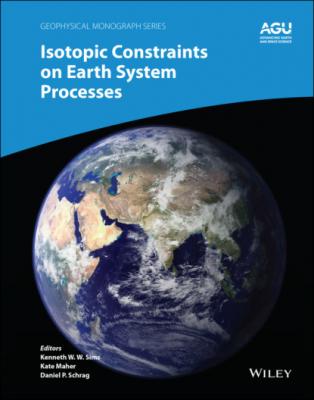Isotopic Constraints on Earth System Processes. Группа авторов
Чтение книги онлайн.
Читать онлайн книгу Isotopic Constraints on Earth System Processes - Группа авторов страница 16
 coefficient (i.e., n = 2 in equation 1.3) and thus given a diffusion profile of a component i one can in most cases fit the data using equation 1.2 to determine the effective binary diffusion coefficient
coefficient (i.e., n = 2 in equation 1.3) and thus given a diffusion profile of a component i one can in most cases fit the data using equation 1.2 to determine the effective binary diffusion coefficient 1.2.3. Self‐Diffusion Coefficients
A very basic type of diffusion coefficient is the self‐diffusion coefficient that measures of the intrinsic mobility of a species. A common experimental approach for measuring self‐diffusion coefficients is to locally alter the isotopic composition of the element of interest in an otherwise homogeneous medium and observe the rate at which the isotopic difference spreads. In effect, this eliminates all diffusive coupling to the other species because their gradients are all zero. The self‐diffusion coefficient
1.2.4. Thermal (Soret) Diffusion Coefficients
The flux equation of a system that is inhomogeneous in both composition and temperature will have terms proportional to both the chemical gradient and the temperature gradient. Expanding the binary diffusion representation of the flux to include the effect of a temperature gradient results in a binary flux equation of the form (Tyrell, 1961)
Figure 1.1 Normalized concentration of CaO, MgO, K2O, FeO, and SiO2 measured across glass recovered from a molten rhyolite‐basalt diffusion experiment are superimposed to show the similarity of the effective diffusivity of all the major oxide components. For the purpose of this comparison, the concentration differences were normalized by (C‐CL)/(CH‐CL), where C is the concentration of a component along the profile, CL is its concentration in the low end‐member, and CH is its concentration in high end‐member.
Figure taken from Richter et al. (2003).
(1.6)
where ρ is the bulk density,
1.3. KINETIC ISOTOPE FRACTIONATION DURING DIFFUSION BETWEEN NATURAL MELTS
The earliest report of measurable differences in the mobility of isotopes of a major element in a silicate liquid was reported by Richter et al. (1999) based on the results of a diffusion experiment involving an isothermal and isochemical CaO‐Al2O3‐SiO2 melt with an initial step with different concentration of 48Ca and 40Ca but with the same isotopic ratio of 48Ca/40Ca on both sides of the step. When annealed, this setup would cause 48Ca and 40Ca to race each other as they diffused into the low concentration side of the couple. A well‐resolved isotopic fractionation in the glass recovered from this experiment showed that 40Ca had diffused measurably faster than 48Ca. The relative mobility of the calcium isotopes was reported as D48 /D40 = (40/48) β with β = 0.075 ± 0.025. Subsequent laboratory experiments by Richter et al. (2003; 2008; 2009b; 2014a) addressed the question of whether the relative mobility of isotopes seen in isochemical experiments would also arise in molten systems where chemical potential gradients are present and where there can be significant coupling between the various diffusing components of the melt.
1.3.1. Laboratory Experiments Documenting Ca Isotope